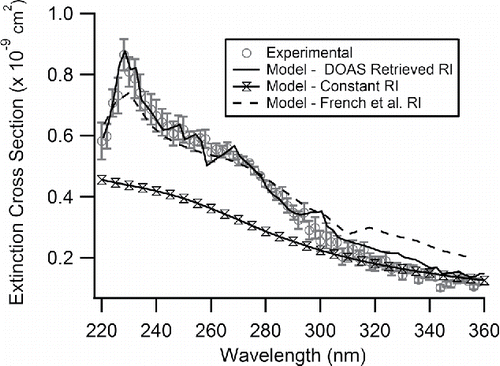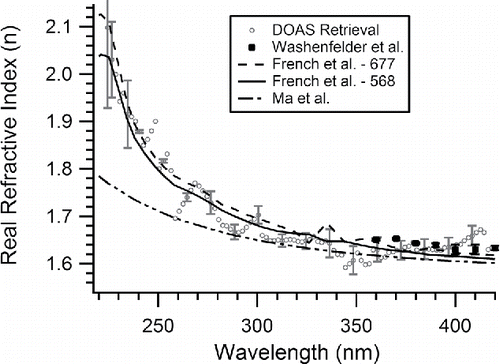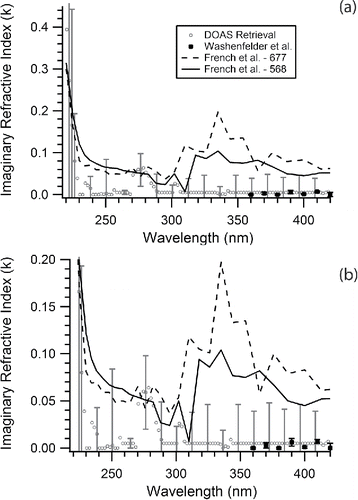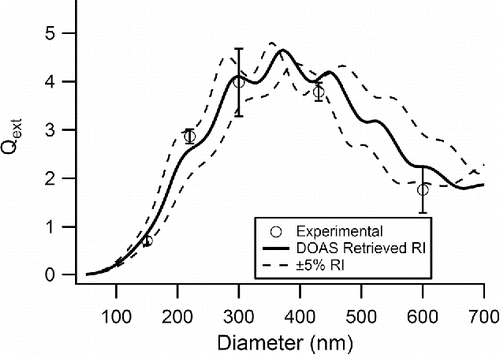Figures & data
Figure 1. The complete experimental design used for broadband extinction measurements. The path through the system starts on the left with aerosol generation from a sample solution using nitrogen in an atomizer block. The aerosol is then dried before size selection with a DMA. Optical extinction is measured next with the AE-DOAS and finally number concentration is measured with the CPC. The abbreviations used are: DMA: differential mobility analyzer; AE-DOAS: aerosol extinction differential optical absorption spectrometer; LDA: linear diode array; Xe source: xenon lamp; CPC: condensation particle counter.

Figure 2. The measured extinction cross section for 150 nm PSLs using the AE-DOAS shown as open grey circles. The error bars on the measured values represent 1 σ of the mean. Shown for comparison are Mie Theory calculations based on various CRI. The solid black line represents the CRI retrieved in this manuscript, the dashed black line represents the CRI for polystyrene-568 measured by French et al. (Citation2007), and the open hour glasses represent a constant RI supplied by the manufacturer at the wavelength of 589 nm. Points are connected by lines to guide the eye where the French et al. (Citation2007) data is reported at larger intervals than the AE-DOAS data.

Table 1. Path length and number of trials averaged to calculate Qext for the various sized PSLs. The uncertainty on the diameter of the PSL in solution ranges from ≤3% to ≤5%. Fewer trials of 600 nm spheres were completed as it was more challenging to obtain the necessary particle number concentration.
Figure 3. The real portion (n) of the CRI versus wavelength retrieved from this work with literature values. The open grey circles represent the retrieved values from the AE-DOAS with error bars representing the retrieval uncertainty, the solid black squares represent the data from Washenfelder et al. (Citation2013), the dashed line represents polystyrene-677 from French et al. (Citation2007), the solid black line represents polystyrene-568 from French et al. (Citation2007), and the dashed-dotted line represents the values generated from the Cauchy coefficients extrapolated below 370 nm from Ma et al. (Citation2003). Lines are used for the French et al. (Citation2007) and Ma et al. (Citation2003) data to guide the eye where data is available at larger intervals than the AE-DOAS data. Only ∼20% of the data is shown with error bars for clarity. Numerical values and uncertainties for the retrieved refractive index are presented in Table S1 in the online supplementary information.

Table 2. Cauchy dispersion equation coefficients determined for polystyrene latex spheres based on fitting Equation (Equation5[5] ). This work focuses on utilizing the retrieved real refractive index at UV-Vis wavelengths from 220–420 nm. Whereas, the Ma et al. (Citation2003) values are based on the 390–1310 nm wavelength range and the Matheson and Saunderson (Citation1952) values are based on measurements from 436–767 nm.
Figure 4. (a) The imaginary portion (k) of the CRI versus wavelength retrieved from this work with literature values. The open grey circles represent the retrieved values from the AE-DOAS with error bars representing the retrieval uncertainty, the solid black squares represent the data from Washenfelder et al. (Citation2013), the dashed line represents polystyrene-677 from French et al. (Citation2007), and the solid black line represents polystyrene-568 from French et al. (Citation2007). Lines are used for the French et al. (Citation2007) data to guide the eye. (b) An expanded view of panel (a) in the wavelength range from 240–420 nm to show detail. Only ∼20% of the data is shown with error bars for clarity. Numerical values and uncertainties for the retrieved refractive index are presented in Table S1 in the online supplementary information.

Figure 5. Extinction efficiency versus diameter for PSLs measured at λ = 228 nm with the AE-DOAS. The open circles represent the measured values with errors bars representing 1 σ of the mean, the solid black line is the Mie Theory extinction calculated using the retrieved CRI from this work, and the dashed line represents Mie Theory extinction calculated for ±5% of both portions of the retrieved CRI.

Figure 6. Extinction efficiency versus diameter for PSLs measured at λ = 351 nm with the AE-DOAS. The open circles represent the measured values with errors bars representing 1 σ of the mean, the solid black line is the Mie Theory extinction calculated using the retrieved CRI from this work, and the dashed line represents Mie Theory extinction calculated for ±5% of both portions of the retrieved CRI.

